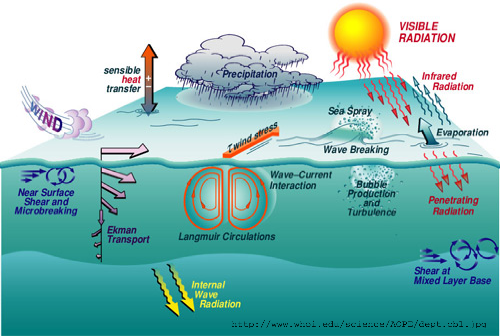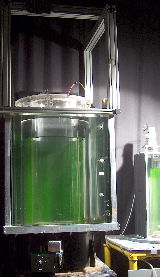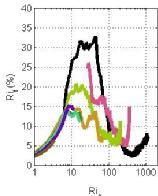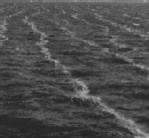Mixing of density interfaces by Taylor-Couette flow
The aim of this work is to study the mixing of stratified fluid by anisotropic flows. It's part of a larger project on the mixing of the ocean upper layer. Applications can also be found in all the situations dealing with fluids of different density (atmosphere, ventilation, pollutions...). Details on the mixing have been obtained using measurements on the evolution of a two-layer Taylor-Couette flow.
Experimental Conditions:
Two different Taylor-Couette devices are employed, one of the classical type with a thin gap of d=1 cm and a more unconventional one with d=5 cm. This allow to reach Reynolds numbers (Re = ωad/ν with ω the cylinder rotation frequency) from 100 and 4000.
A typical experiment starts with the TC device filled by a stable bi-layers of fresh and salted water. Then the rotation inner cylinder induces the formation of Taylor-vortices which are responsible for the mixing of the two layers. We use the PLIF techniques to measure the time evolution of the vertical density profile and PIV
techniques to measure the time evolution of the vertical density profile and PIV to quantify the intensities of the mixing sources (Taylor-vortices).
to quantify the intensities of the mixing sources (Taylor-vortices).
Results:
In the turbulent regime, experiments conducted show for the first time evidences of an increase in mixing efficiency at large Richardson numbers. With increasing buoyancy gradient the buoyancy flux first passes a maximum, then decreases and at large values of the buoyancy gradient the flux increases again. Thus, the curve of buoyancy flux versus buoyancy gradient tends to be N-shaped (rather than simply bell shaped), a behaviour suggested by the model of Balmforth et al. (1998). The increase in mixing efficiency at large Richardson numbers is attributed to a scale separation of the eddies active in mixing at the interface; when the buoyancy gradient is large mean kinetic energy is injected at scales much smaller than the eddy size fixed by the gap width, thus decreasing the eddy turnover time. Observations show that there is no noticeable change in interface thickness when the mixing efficiency increases; it is the mixing mechanism that changes. The curves of buoyancy flux versus buoyancy gradient also show a large variability for identical experimental conditions. These variations occur at time scales one to two orders of magnitude larger than the eddy turnover time scale (Guyez et al, JFM 2007![]() ).
).
In the laminar regimes, the efficiency is an order of magnitude smaller than the efficiency in the turbulent regime. The vertical transport in the homogeneous layers is smaller than the interfacial flux and several density interfaces appear at different heights. The interactions between the interfaces control the subsequent density flux, and hence the mixing efficiency (Guyez et al, CFM 2007 ![]() ).
).
Application to Geophysical Flow: Langmuir circulation
The Taylor vortex flow that mixes the density interface in the Taylor-Couette device has many similarities with the Langmuir circulation (LC) which interacts with oceanic pycnocline; both have horizontal vortex axis. The symmetry plane of the Langmuir vortices is in the Taylor-Couette flow replaced by the cylinder wall. Li et al. (1995) have established a criteria which stipulates that the deepening of the surface layer due to LC is inhibited when Ri0 > 12. In the Taylor-Couette experiments, this is the limiting value beyond which the entrainment rate is no longer constant and starts to decrease very rapidly. Thus, the depth of the oceanic surface layer can be considered to remain nearly constant when Ri0 > 12. In the Taylor-Couette experiments the non-dimensional entrainment rate E for Ri0 < 12 is 10−2, a value comparable with those measured for Langmuir Circulation mixing during a storm event. Smith (1998) finds an entrainment velocity Ue =0.14mm.s−1 which, with the rms velocity Urms =1.5cm.s−1 in LC cells, yields a very comparable non-dimensional entrainment rate (Guyez et al, ISSF 2007 ![]() ) .
) .

Various processes involved in the mixing of the ocean upper layer
SUPERVISORS: Emil J. Hopfinger, Professor Emeritus, Emil.Hopfinger@hmg.inpg.fr
Jan-Bert Flor, Doctor HDR, jan-bert.flor@hmg.inpg.fr

LIF technics used in Taylor-Couette devices

Mixing efficiency Rif at Re=3409 for different initial density jumps.

Langmuir circulation view from the sky
